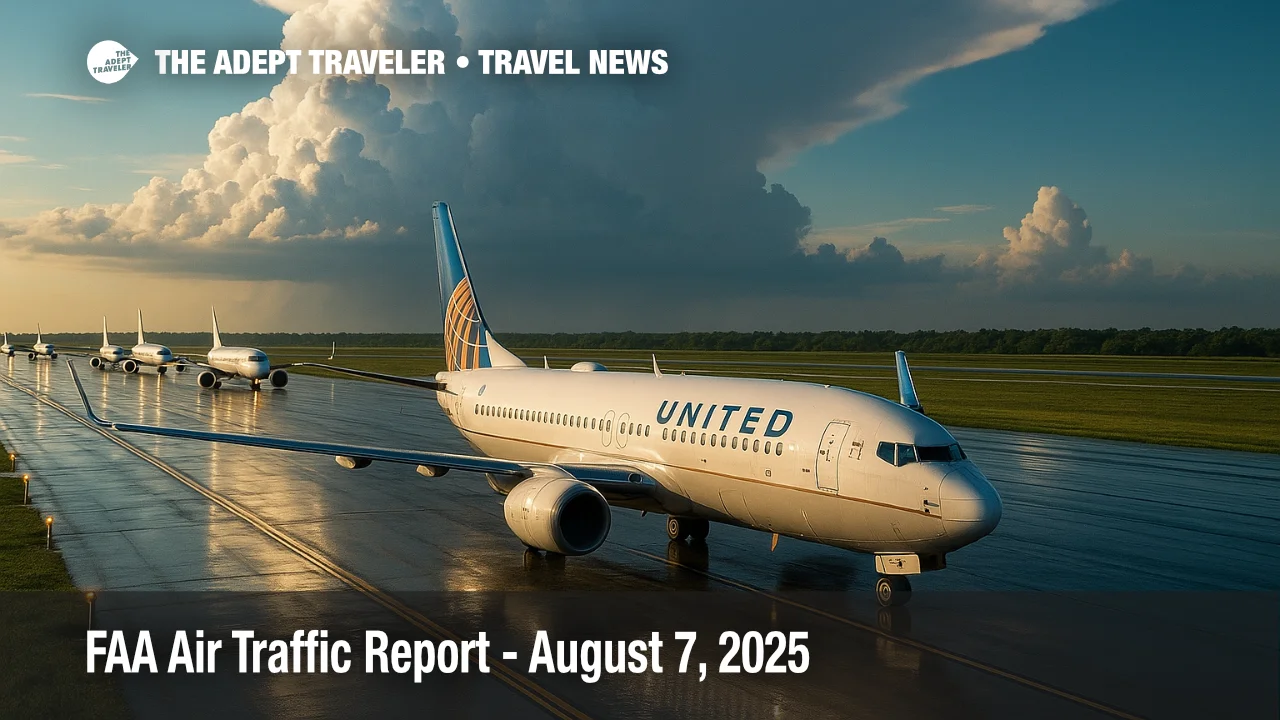FAA Air Traffic Report - August 7, 2025

Afternoon thunderstorms across Florida and the Gulf Coast, low clouds hugging West Coast hubs, and persistent wildfire smoke near Denver headline today's National Airspace System outlook. The FAA's morning operations plan flags potential ground stops at Miami, Fort Lauderdale, Orlando, Tampa, Newark, and the two Houston airports, while Las Vegas may see wind-related programs. Travelers should monitor airline alerts and consider earlier departures or longer connection times.
Key Points
- Why it matters: Thunderstorms could halt take-offs and landings at five major Florida airports.
- Travel impact: Delay programs possible this afternoon at MIA, FLL, MCO, TPA, and EWR.
- What's next: FAA will update traffic management initiatives after the 9:15 a.m. ET planning webinar.
- West Coast hubs face morning low ceilings; Las Vegas contends with gusty winds.
- Smoke may slow Denver arrivals; SpaceX launch window could trigger Atlantic route closures.
Snapshot
The Air Traffic Control System Command Center's 12 zulu plan keeps staffing level C in place through midday while it watches a stubborn storm line over central Florida. No terminal initiatives are active as of 7:30 a.m. ET, but multiple "possible" flags are posted for late afternoon. En-route thunderstorms stretch from Jacksonville Center south into Miami Center airspace, and convective SIGMETs may expand northward. Out West, Seattle, San Francisco, Los Angeles, and San Diego start the day under low ceilings, though improvement is expected by mid-morning. Wind shear at Las Vegas and haze from Rocky Mountain wildfires round out the main hazards.
Background
The FAA publishes a Daily Air Traffic Report outlining expected weather and operational constraints for the National Airspace System. Airlines and dispatchers use this forecast, along with real-time advisories, to plan routings and adjust schedules. A ground delay program meters arrivals into an airport; a ground stop holds departures entirely. Traffic-management specialists refine the plan every two hours during peak periods, balancing runway capacity, sector workload, and equipment outages. Today's brief comes on the heels of an Aug. 6 technology glitch at United Airlines that triggered nearly 1 ,100 flight delays and a temporary FAA ground stop for the carrier, adding strain as the busy summer season peaks.
Latest Developments
Florida Storms Could Trigger Multiple Ground Stops
Convective models show seabreeze-driven thunderstorms flaring after 12:00 p.m. ET across the peninsula. The FAA plan lists "after 1600 z" ground stop or delay-program possibilities for Miami International Airport (MIA) and Fort Lauderdale-Hollywood International Airport (FLL), extending to Orlando (MCO) and Tampa (TPA) after 1700 z. If storms park over terminal arrival fixes, airborne holding may precede full stops, so travelers should pack snacks and download airline apps for push alerts.
East-Coast Volume Adds Newark to the Watch List
Although weather in the Northeast is benign, the Command Center warns that heavy departure volume could force Newark Liberty International Airport (EWR) into a ground delay program after 1:00 p.m. ET. Philadelphia (PHL) night runway work and New York air-route frequency outages further tighten capacity. Crews may reroute traffic via inland fixes to relieve New York Center, adding minutes-in-trail spacing on major trans-Atlantic tracks.
West-Coast Ceilings and Las Vegas Wind Persist
Sea-layer clouds sit beneath 1,000 feet at Seattle-Tacoma (SEA), San Francisco (SFO), Los Angeles (LAX), and San Diego (SAN) through the morning push. Models clear most ceilings by 10:00 a.m. PT, but early-bank commuters should expect minor departure holds. Farther inland, Harry Reid International Airport (LAS) may enact brief wind-mitigation programs as gusts top 25 knots. Smoke from Western wildfires lingers over Denver International Airport (DEN), prompting controllers to slow arrival rates until visibility improves.
Analysis
Today's constraints illustrate the seasonal tug-of-war between convective weather and peak-summer passenger demand. Florida's storm pattern is classic: late-day cells blossom exactly when outbound leisure traffic peaks, compressing a full-day schedule into shorter usable blocks. Carriers often pre-cancel evening rotations, but passengers on earlier flights still risk diversions if arrival fixes shut down. Newark's volume warning highlights chronic Northeast congestion. Even absent storms, limited runway configurations leave little margin; a single equipment outage forces air-space flow programs that ripple to Chicago and Atlanta. Out West, marine-layer ceilings typically lift by mid-morning, yet early-bank delays cascade to trans-con departures, tightening gate utilization. Add in gusty desert winds and sporadic wildfire smoke, and airlines must juggle swaps, route caps, and recovery ferry flights. Meanwhile, yesterday's United outage underscores system fragility: a carrier-specific tech failure prompted an FAA-backed ground stop, revealing interdependencies between airline IT and national traffic flows. The Command Center's vigilant two-hour planning cadence seeks to balance these variables, but travelers should anticipate rolling adjustments throughout the day.
Final Thoughts
With thunderstorms, low ceilings, and volume pressures converging, proactive itinerary management is critical. Re-check departure times, enable push notifications, and consider lounge access or flexible rebooking to buffer potential disruptions. Staying informed through the FAA daily air traffic report can turn a stressful travel day into a manageable one.
